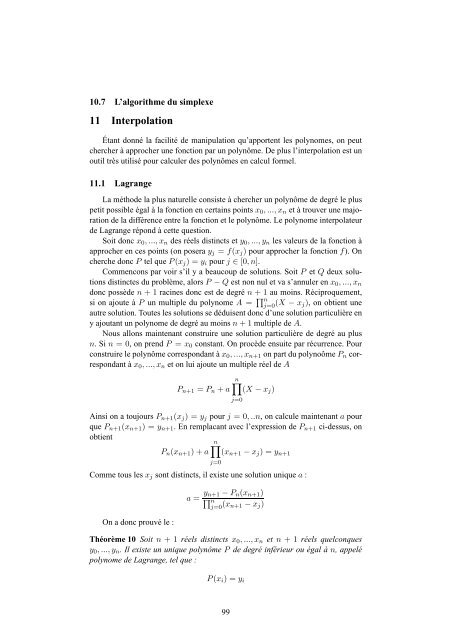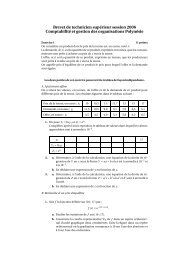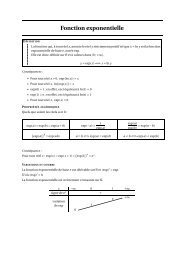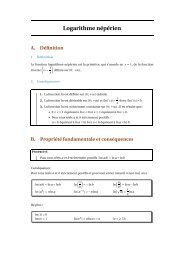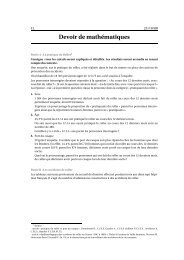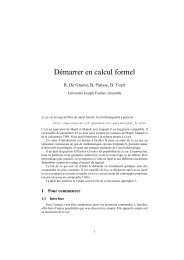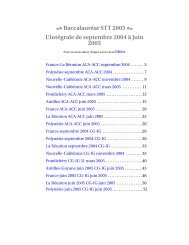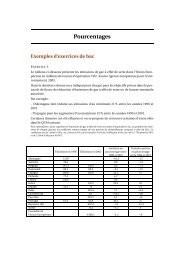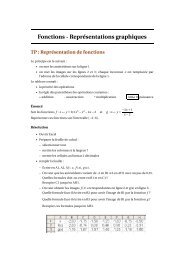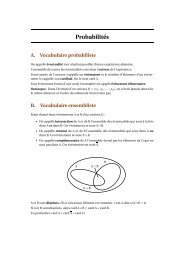Algorithmes de calcul formel - Free
Algorithmes de calcul formel - Free
Algorithmes de calcul formel - Free
- No tags were found...
You also want an ePaper? Increase the reach of your titles
YUMPU automatically turns print PDFs into web optimized ePapers that Google loves.
10.7 L’algorithme du simplexe11 InterpolationÉtant donné la facilité <strong>de</strong> manipulation qu’apportent les polynomes, on peutchercher à approcher une fonction par un polynôme. De plus l’interpolation est unoutil très utilisé pour <strong>calcul</strong>er <strong>de</strong>s polynômes en <strong>calcul</strong> <strong>formel</strong>.11.1 LagrangeLa métho<strong>de</strong> la plus naturelle consiste à chercher un polynôme <strong>de</strong> <strong>de</strong>gré le pluspetit possible égal à la fonction en certains points x 0 , ..., x n et à trouver une majoration<strong>de</strong> la différence entre la fonction et le polynôme. Le polynome interpolateur<strong>de</strong> Lagrange répond à cette question.Soit donc x 0 , ..., x n <strong>de</strong>s réels distincts et y 0 , ..., y n les valeurs <strong>de</strong> la fonction àapprocher en ces points (on posera y j = f(x j ) pour approcher la fonction f). Oncherche donc P tel que P(x j ) = y i pour j ∈ [0, n].Commencons par voir s’il y a beaucoup <strong>de</strong> solutions. Soit P et Q <strong>de</strong>ux solutionsdistinctes du problème, alors P − Q est non nul et va s’annuler en x 0 , ..., x ndonc possè<strong>de</strong> n + 1 racines donc est <strong>de</strong> <strong>de</strong>gré n + 1 au moins. Réciproquement,si on ajoute à P un multiple du polynome A = ∏ nj=0 (X − x j), on obtient uneautre solution. Toutes les solutions se déduisent donc d’une solution particulière eny ajoutant un polynome <strong>de</strong> <strong>de</strong>gré au moins n + 1 multiple <strong>de</strong> A.Nous allons maintenant construire une solution particulière <strong>de</strong> <strong>de</strong>gré au plusn. Si n = 0, on prend P = x 0 constant. On procè<strong>de</strong> ensuite par récurrence. Pourconstruire le polynôme correspondant à x 0 , ..., x n+1 on part du polynoôme P n correspondantà x 0 , ..., x n et on lui ajoute un multiple réel <strong>de</strong> AP n+1 = P n + an∏(X − x j )Ainsi on a toujours P n+1 (x j ) = y j pour j = 0, ..n, on <strong>calcul</strong>e maintenant a pourque P n+1 (x n+1 ) = y n+1 . En remplacant avec l’expression <strong>de</strong> P n+1 ci-<strong>de</strong>ssus, onobtientn∏P n (x n+1 ) + a (x n+1 − x j ) = y n+1j=0j=0Comme tous les x j sont distincts, il existe une solution unique a :a = y n+1 − P n (x n+1 )∏ nj=0 (x n+1 − x j )On a donc prouvé le :Théorème 10 Soit n + 1 réels distincts x 0 , ..., x n et n + 1 réels quelconquesy 0 , ..., y n . Il existe un unique polynôme P <strong>de</strong> <strong>de</strong>gré inférieur ou égal à n, appelépolynome <strong>de</strong> Lagrange, tel que :P(x i ) = y i99


